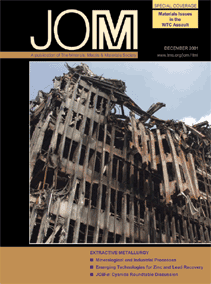 |
NEWS & UPDATE
|
|---|
 |
NEWS & UPDATE
|
|---|
|
|
|---|
 |
|
OTHER ARTICLES IN THE WTC SERIES |
| Why Did the World Trade Center Collapse? Science, Engineering, and Speculation by Thomas Eagar and Christopher Musso Better Materials Can Reduce the Threat from Terrorism by Toni G. Maréchaux An Initial Microstructural Analysis of A36 Steel from WTC Building 7 by J.R. Barnett, R.R. Biederman, and R.D. Sisson, Jr. |
|
|
In the aftermath of the terrorist attacks in New York and Washington, D.C.,
engineering groups rallied to conduct a variety of studies, ensuring the safety
of search and rescue workers and gathering evidence before it was land-filled
or recycled. When the analyses are complete, the professionals hope to understand,
in detail, why the buildings failed, particularly the World Trade Center towers.
For instance, the American Society of Civil Engineers (ASCE) formed teams
to work with local officials in New York and Washington to collect and evaluate
data from the scenes. The work will be distilled into a report for ASCE membership
and other interested parties. That report is expected to be completed in the
spring of 2002.
To help ASCE collect data, the Structural Engineers Association of New York
issued a call for volunteers to work at the two scrap yards in New Jersey
receiving steel from the World Trade Center.
The teams of engineers were posted at each salvage yard, watching for potential
evidence. In particular, the engineers looked for steel from the floors where
the airplanes hit and where the fires broke out. Close examination of the
debris could provide that information. When the twin towers were built, each
piece of steel was stamped with its location in the buildings. No details
have been released about the teams' findings.
The New York engineers association also is collecting information about the
buildings, including photographs before, during, and after their destruction,
observations of specific structural or fire damage, or any other technical
information. In addition, the group is asking for similar information about
buildings still standing adjacent to the World Trade Center site.
Volunteers from the organization continue to assist at "ground zero"
by assessing the structural stability of the debris and shoring safe routes
for equipment. The group helped to assess damage to some 400 area buildings,
to determine the extent of peripheral damage caused by the tower collapse.
The American Institute of Steel Construction (AISC) also was represented among
the professionals evaluating the evidence of the World Trade Center collapse.
The group, consisting of a core team of six people and another ten advisers,
arrived at the disaster site in early October, said Scott Melnick, vice president
of communications for AISC. The group’s investigation was expected to
last for several months, with a final report anticipated within nine months
to a year.
“They are evaluating not just the physical rubble, but doing computational
analyses to create a model of the collapse,” Melnick said.
The AISC is a non-profit association representing the United States structural
steel industry. The organization develops and maintains standards for design
and construction of steel buildings in the United States.
The final report from the WTC investigation will be turned over to the Federal
Emergency Management Agency, which coordinates U.S. disaster relief efforts.
Direct questions about this or any other JOM page to jom@tms.org.
| If you would like to comment on the December 2001 issue of JOM, simply complete the JOM on-line critique form | |||||
|---|---|---|---|---|---|
| Search | TMS Document Center | Subscriptions | Other Hypertext Articles | JOM | TMS OnLine |